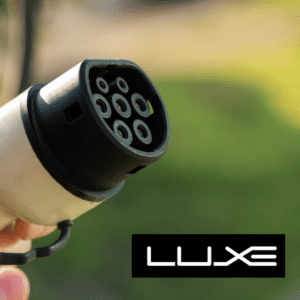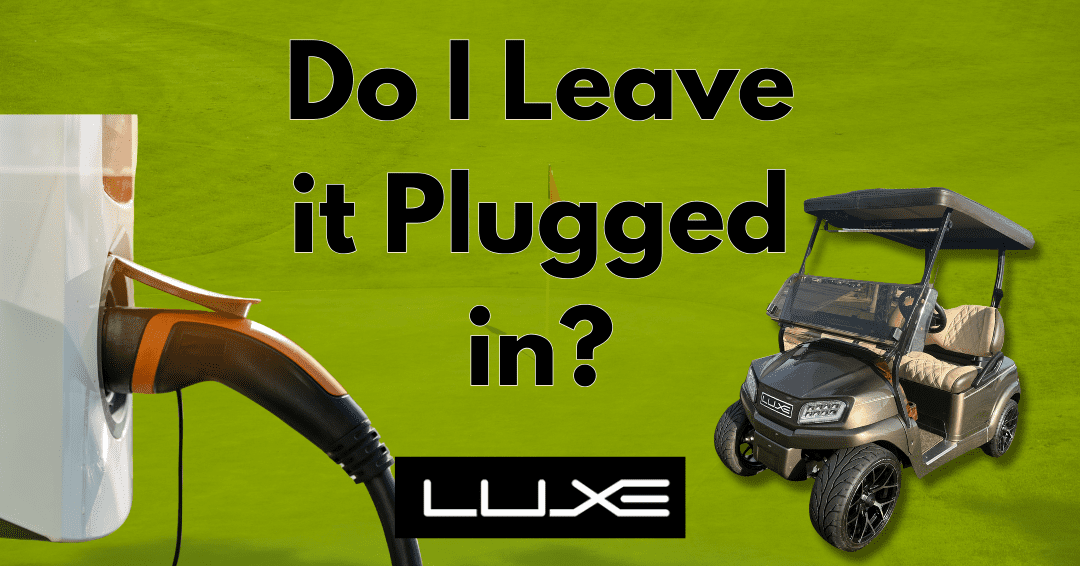Electric golf carts are a convenient, eco-friendly transportation option, but proper battery maintenance is crucial to ensure their longevity and efficiency. One of the most common questions among electric golf cart owners is whether they should keep their cart plugged in when not in use. The answer depends on the type of battery your cart uses.
Understanding Battery Types and Charging Needs
Different types of batteries require different maintenance approaches. Let’s break down the best practices for lead-acid and lithium batteries to keep your golf cart running smoothly.
Read more: Golf Cart Registration in California: Costs, Requirements, and Tips | LUXE
Lead-Acid Batteries: Charge and Monitor
 Lead-acid batteries are a more traditional power source for electric golf carts, but they require careful maintenance to prevent deterioration.
Lead-acid batteries are a more traditional power source for electric golf carts, but they require careful maintenance to prevent deterioration.
- When you plug in the cart, it charges fully and then deactivates the charger.
- Over time, if left unplugged, the batteries will slowly discharge and may lose their charge completely.
- If left unused for weeks or months without periodic recharging, the batteries may go into a deeply discharged state, making it harder to restart the cart.
- Unlike lithium batteries, lead-acid batteries tend to self-discharge at a higher rate, meaning they lose power even when not in use.
- Deep discharges can reduce battery lifespan and lead to expensive replacements.
Best Practice: If you plan to leave your golf cart unused for an extended period, consider recharging it every few weeks or using a trickle charger to maintain optimal battery health. A trickle charger will automatically keep the battery topped off without overcharging it.
Read more: How to Make Your Golf Cart Street Legal: A Complete Guide
Lithium Batteries: Two Types, Two Approaches
Lithium batteries are gaining popularity due to their superior longevity, efficiency, and lower maintenance requirements. However, the type of lithium battery in your golf cart determines its maintenance needs.
Read more: How Long Should My Charge Last on My Golf Cart Batteries?
RoyPow 105-Amp Lithium Battery System
- When at home: Keep the cart plugged in when not in use.
- When leaving for more than a week: Simply turn off the power button to preserve battery life.
- Reactivating after a break: When you return, turn the power button back on, plug the cart in, and let it charge overnight to ensure a full cycle.
- This type of lithium battery has built-in Battery Management System (BMS) that prevents overcharging and excessive depletion.
- Proper maintenance ensures a lifespan of 10+ years, significantly longer than lead-acid batteries.
LUXE 140-Amp Lithium Battery System
- Unlike the RoyPow system, this does not have a power button.
- Keep it plugged in 100% of the time, even if you are away for weeks or months.
- The BMS system manages the charge, ensuring the battery remains at an optimal level without overcharging.
- Even after long periods of inactivity, the battery will be ready for immediate use upon return.
- Lithium batteries charge much faster than lead-acid batteries, reducing downtime and making them ideal for frequent use.
Why Proper Battery Maintenance Matters
Proper charging and maintenance routines are essential for extending the life of your golf cart’s battery. Here’s why you should follow best practices:
- Cost Savings: Golf cart batteries are expensive. Proper maintenance can double their lifespan, saving you money on replacements.
- Performance: A well-maintained battery ensures your cart runs smoothly and efficiently without unexpected power losses.
- Safety: Poorly maintained batteries, especially lead-acid ones, can become a fire hazard due to sulfation and internal damage.
- Convenience: Avoid the hassle of dealing with a dead battery when you need to use your cart.
Read more: How Much Does It Cost to Replace My Golf Cart Batteries
Common Mistakes to Avoid
To maximize battery performance, avoid these common mistakes:
- Leaving a lead-acid battery uncharged for too long: This can cause sulfation, permanently reducing battery capacity.
- Unplugging a lithium battery that requires continuous charging: Some lithium systems, like the LUXE 140-Amp, must remain plugged in at all times.
- Charging a battery in extreme temperatures: High heat can shorten battery life, while freezing conditions can reduce performance.
- Overcharging a battery: Although modern lithium systems have BMS, older lead-acid batteries can become overcharged if left on outdated chargers.
Read more: What Questions Should I Ask When Buying a Golf Car?
Final Recommendations for Long-Term Battery Health
- Know Your Battery Type: Whether lead-acid or lithium, understanding your battery’s needs helps avoid unnecessary damage.
- Follow Manufacturer Guidelines: Always refer to your golf cart’s manufacturer recommendations for optimal charging practices.
- Regular Maintenance: Periodic checkups and cleaning battery terminals can prolong battery life and improve efficiency.
- Invest in the Right Charger: A high-quality smart charger can prevent overcharging and help regulate power levels efficiently.
- Store Your Cart Properly: If storing for extended periods, keep lithium batteries plugged in (if required) and check lead-acid batteries periodically.
Read more: How Often Should I Add Water to Golf Cart Batteries?
 By following these guidelines, you’ll ensure your electric golf cart remains in top condition, whether you’re using it daily or storing it for an extended period.
By following these guidelines, you’ll ensure your electric golf cart remains in top condition, whether you’re using it daily or storing it for an extended period.
Looking for a premium electric golf cart with the latest lithium battery technology? Contact LUXE Electric Car today to explore our top-of-the-line models built for efficiency and long-term reliability.
Will It Hurt a Golf Cart to Keep It Plugged In?
It depends on the battery type. For lithium batteries with a Battery Management System (BMS), like the RoyPow or LUXE systems, it is generally fine to keep them plugged in as they prevent overcharging. However, for lead-acid batteries, leaving them plugged in for too long without a smart charger may result in overcharging, which can damage the battery. It’s always best to follow the manufacturer’s guidelines for the specific battery type.
Should I Leave My Electric Golf Cart Plugged in All Winter?
For lithium batteries, it is generally safe to keep them plugged in during winter, especially if your system has a BMS that regulates the charging process. For lead-acid batteries, it’s best to avoid letting them sit without being periodically charged. If you’re not using your golf cart for a long period, consider charging the lead-acid battery every few weeks or using a trickle charger to maintain its charge.
How Long Can a Golf Cart Sit Without Being Driven?
Lead-acid batteries can sit for about 2-4 weeks before they start losing charge, but if left for months, they may suffer from deep discharge, reducing lifespan. Lithium batteries can sit for longer periods without significant power loss, but it depends on the system. Generally, lithium batteries can sit for several months without issues, especially if kept plugged in (for systems like LUXE 140-Amp that require continuous charging).
Should I Plug in My Golf Cart After Every Use?
Yes, it is a good idea to plug in your golf cart after every use to ensure the battery stays fully charged, especially for lead-acid batteries, which self-discharge over time. For lithium batteries, it’s not as crucial to plug in immediately after every use, but it’s still recommended to keep the battery topped off, especially if you plan on using the cart again soon.
How Do I Prolong the Life of My Golf Cart Batteries?
- Lead-acid batteries: Avoid letting them discharge completely, keep them charged, and don’t leave them uncharged for long periods. Use a trickle charger for long-term storage.
- Lithium batteries: For systems like RoyPow, it’s best to leave them plugged in when not in use or turn off the power button for longer periods. Ensure the system’s BMS is doing its job to manage charging cycles effectively. Keep batteries in moderate temperatures to avoid heat-related damage.
Why Might You Want to Unplug a Golf Cart?
- Lead-acid batteries might need to be unplugged if the charger doesn’t have an automatic shutoff or is outdated, as overcharging can shorten battery life.
- For lithium batteries with a BMS, unplugging may be necessary if the system is designed to avoid charging at full capacity for too long, but in most cases, they should be left plugged in to ensure they are kept at optimal charge.




